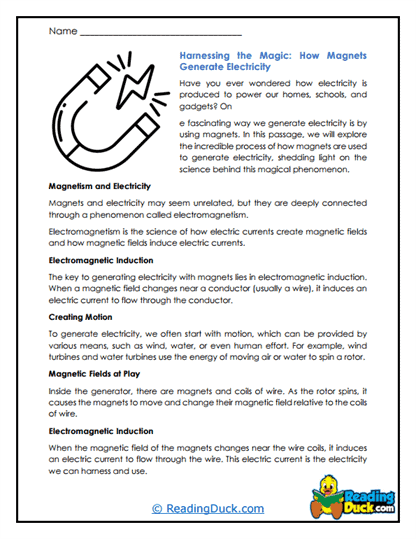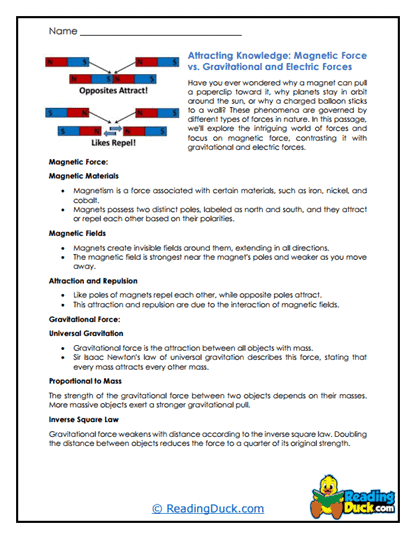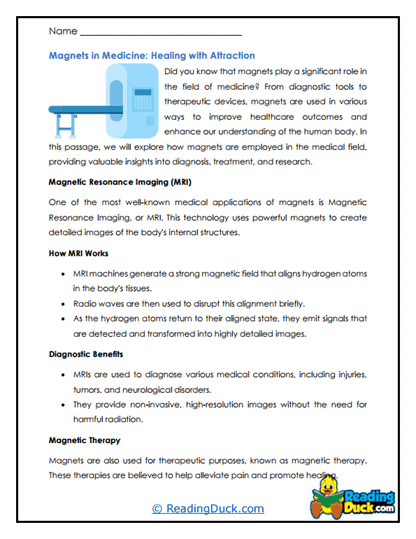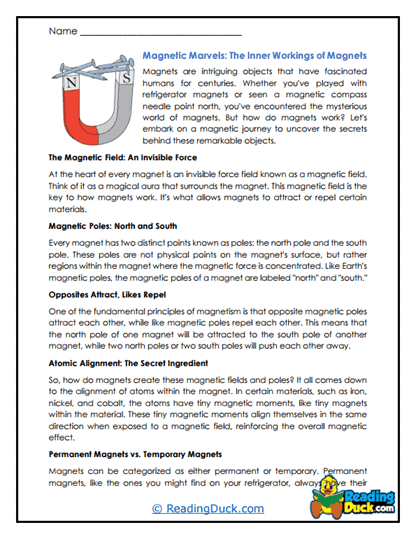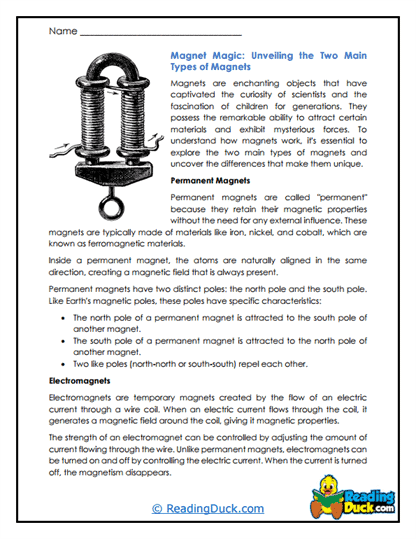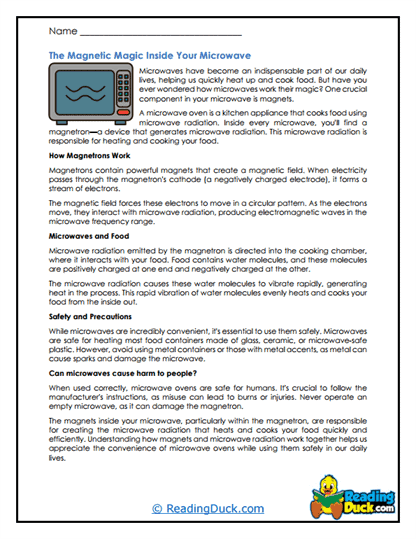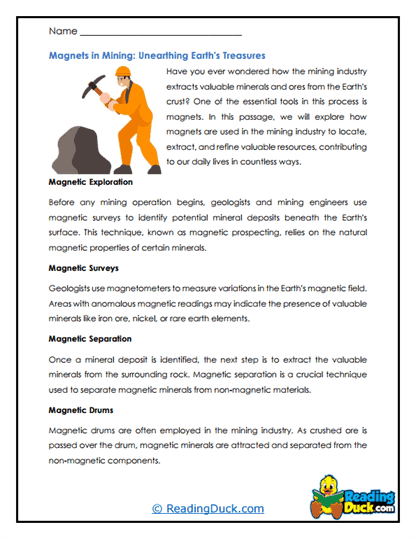Magnetism Worksheets
About Our Magnetism Worksheets
Our Magnetism worksheets are designed to provide a thorough and engaging exploration of the fundamental principles of magnetism, a vital subtopic within the field of Physics. These worksheets guide students through the basics of magnetism, including magnetic fields, the properties of magnets, and the practical applications of magnetism in everyday life. Each worksheet set is crafted to foster a deeper understanding of the concepts through a combination of informative reading passages and a variety of comprehension questions that cater to different learning styles.
Each worksheet set includes:
- Multiple Choice Questions: These questions assess students' comprehension of the reading passage, reinforcing key concepts and ensuring they can recall and apply important information.
- Short Answer Questions: These prompts encourage students to explain concepts in their own words, deepening their understanding and helping them articulate their thoughts clearly.
- Open-Ended Questions: These questions invite students to reflect on the material, express their opinions, and connect the concepts to real-world scenarios, fostering critical thinking and personal engagement with the topic.
Each question sheet comes with an answer key to facilitate easy and accurate grading, making it simpler for teachers and parents to guide students. The worksheets are available as PDF files, which can be viewed electronically, downloaded, and printed out for use in various educational settings.
Unlocking the Mysteries of Magnetism: Understanding the Invisible Force
Magnetism is a fascinating and essential force of nature that plays a significant role in our everyday lives, even though it is often invisible to the naked eye. From the simple refrigerator magnets that hold up family photos to the complex magnetic fields that protect our planet, magnetism is all around us. Understanding this invisible force not only helps students grasp the basic principles of physics but also opens their eyes to the many ways in which magnetism influences technology, the environment, and even the functioning of the human body.
1. What is Magnetism?
- Definition and Basic Principles:
- Magnetism is a force that arises from the motion of electric charges, resulting in attractive and repulsive forces between objects. This force is fundamental to many aspects of physics and is closely related to electricity.
- Magnetic Fields:
- A magnetic field is the area around a magnet where magnetic forces are exerted. These fields are represented by lines that flow from the magnet's north pole to its south pole. Understanding magnetic fields helps students visualize how magnets interact with each other and with other materials.
- Types of Magnets:
- Magnets can be classified into natural magnets, such as lodestones, and artificial magnets, which are made by inducing magnetic properties in materials like iron, cobalt, and nickel. There are also electromagnets, which are created by running an electric current through a coil of wire. Each type of magnet has unique properties and uses in technology and industry.
2. How Magnetism Works
- Magnetic Domains:
- The concept of magnetic domains explains why certain materials become magnets. These domains are tiny regions within a material where the magnetic moments of atoms are aligned in the same direction. When these domains align, the material itself becomes magnetized.
- Magnetic Poles:
- Every magnet has two poles: a north pole and a south pole. Like poles repel each other, while opposite poles attract. This simple yet powerful principle explains how magnets interact with each other and with other materials.
- Earth as a Magnet:
- The Earth itself acts as a giant magnet, with a magnetic field that extends from the North Magnetic Pole to the South Magnetic Pole. This field protects the planet from solar wind and cosmic radiation, and it plays a crucial role in navigation, as it causes compass needles to point north.
3. Practical Applications of Magnetism
- Electromagnets:
- Electromagnets are magnets that can be turned on and off by controlling the flow of electricity. They are used in a wide range of applications, from electric motors and generators to MRI machines and maglev trains. Understanding how electromagnets work gives students insight into the practical applications of magnetism in modern technology.
- Magnetic Storage:
- Magnetism is used to store data in devices like hard drives and credit cards. In these devices, tiny magnetic domains are aligned in patterns that represent binary data, allowing vast amounts of information to be stored and retrieved quickly.
- Magnetic Levitation:
- Magnetic levitation, or maglev, is a technology that uses magnetic forces to lift and propel objects without physical contact. This technology is most famously used in high-speed trains, which can travel at incredible speeds with minimal friction. Exploring maglev technology helps students understand the potential of magnetism in future transportation and engineering innovations.
- Healthcare and Magnetism:
- Magnetism plays a crucial role in healthcare, particularly in diagnostic tools like MRI (Magnetic Resonance Imaging) machines. These machines use strong magnetic fields to create detailed images of the inside of the body, helping doctors diagnose and treat medical conditions without invasive procedures.
4. Everyday Examples of Magnetism
- Magnets in the Home:
- From refrigerator magnets to magnetic clasps on bags and jewelry, magnets are ubiquitous in our daily lives. These simple uses of magnetism are a great starting point for students to connect the science of magnetism with their everyday experiences.
- Magnets in Electronics:
- Speakers, microphones, and many other electronic devices rely on magnets to function. For example, in a speaker, an electromagnet is used to convert electrical signals into sound by moving a diaphragm back and forth.
- Navigation and Compasses:
- Compasses are one of the oldest and most practical applications of magnetism. By aligning with the Earth's magnetic field, a compass needle points toward the magnetic north, helping travelers find their way.
Activities to Supplement These Worksheets
To help students further engage with the topic of magnetism and solidify their understanding, teachers and parents can incorporate the following hands-on activities alongside the worksheets:
1. Building a Simple Electromagnet
- Objective: Understand how electricity can create magnetism.
- Activity: Provide students with a battery, copper wire, and a large nail. Have them wrap the wire around the nail and connect the ends to the battery terminals, creating an electromagnet. Students can experiment with picking up small metal objects like paperclips, discovering how the strength of the electromagnet changes with the number of wire coils and the strength of the battery.
2. Exploring Magnetic Fields with Iron Filings
- Objective: Visualize magnetic fields around a magnet.
- Activity: Give students bar magnets and a sheet of paper. By sprinkling iron filings on the paper and gently tapping it, students can observe the pattern of the magnetic field lines as the filings align with the invisible forces. This activity provides a visual representation of an abstract concept, making it easier to understand.
3. Investigating Magnet Poles with Repulsion and Attraction
- Objective: Demonstrate the properties of magnetic poles.
- Activity: Provide students with several bar magnets and have them experiment with bringing different poles together. They can observe how like poles repel and opposite poles attract, reinforcing the fundamental principles of magnetism.
4. Creating a Magnetic Compass
- Objective: Understand how magnets are used in navigation.
- Activity: Have students make a simple compass using a magnetized needle, a cork, and a bowl of water. By floating the needle on the cork, students can see how it aligns with the Earth's magnetic field, pointing north. This activity connects the concept of magnetism with practical navigation tools.
5. Testing Materials for Magnetism
- Objective: Identify magnetic and non-magnetic materials.
- Activity: Provide students with a variety of materials such as coins, keys, aluminum foil, plastic, and wood. Using a magnet, they can test which materials are magnetic and which are not, helping them understand the properties of different substances and why certain materials can become magnets.
6. Experimenting with Magnetic Levitation
- Objective: Explore how magnets can create a levitating effect.
- Activity: Students can use strong magnets and a small object like a paperclip to experiment with magnetic levitation. By carefully positioning the magnets, they can make the object float, demonstrating the principles of magnetic force and balance.
7. Investigating the Strength of Different Magnets
- Objective: Compare the strength of various types of magnets.
- Activity: Provide students with different magnets, such as bar magnets, disc magnets, and electromagnets. Have them measure how many paperclips each magnet can hold or how far each magnet can move a small metal object. This experiment helps students understand the varying strengths of magnets based on their shape, size, and type.
8. Building a Magnet-Powered Car
- Objective: Apply magnetism to create motion.
- Activity: Challenge students to design and build a simple car using magnets and cardboard. By placing magnets on the car and using other magnets to push or pull it, students can explore how magnetic forces can be harnessed to create movement.
9. Exploring Magnetic Resonance Imaging (MRI)
- Objective: Understand the application of magnetism in healthcare.
- Activity: Introduce students to the basics of MRI technology and how strong magnets are used to create images of the inside of the body. While they won't build an MRI machine, students can research and discuss the importance of magnetism in medical diagnostics.
10. Creating a Magnetic Art Project
- Objective: Use magnetism creatively to make art.
- Activity: Provide students with magnets, paper, and iron filings or metal shavings. By moving the magnet under the paper, they can create patterns with the filings, combining science with creativity. This activity encourages students to think about magnetism in a new and artistic way.
The Significance of Understanding Magnetism
Magnetism is more than just a fascinating force of nature; it is a fundamental aspect of the physical world that has practical applications in technology, industry, healthcare, and everyday life. By studying magnetism, students not only gain insight into one of the basic forces that govern the universe but also develop critical thinking skills and an appreciation for how this invisible force impacts their daily lives. Engaging with these worksheets and supplementary activities will equip students with a solid foundation in physics, fostering a deeper understanding of the world around them and inspiring curiosity about the many wonders of science.
